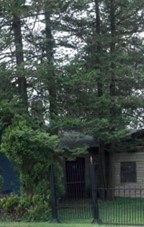Wildfire-resistant landscape plants can protect your home
Build landscape resilience to climate change and drought, heat, and wildfires with fire resistant plants.

Spring is known for being a time of increased incidence of forest and wildfires because the trees, grasses and other plants are dry or dead from winter desiccation. Additionally, climate change is a factor in more frequent wildfires. Michigan can annually experience as many as 10,000 to 12,000 wildfires, impacting thousands of acres and destroying hundreds of buildings each year.
Many of Michigan’s natural communities rely on fire as an important ecological process for maintaining open conditions. While many fires are caused from burning yard debris, others occur naturally. Protecting your home from this threat can be enhanced through careful landscaping and plant selection.

Installing the right kind of plants growing near your home can mean the difference between saving and losing your home to a wildfire. For example, a conifer tree that has a lot of dead lower branches or built-up needles on the ground can “torch” during a wildfire. If that tree were growing next to your home, it could ignite your house from both proximity and fire brands drifting from the burning plant.
“Many Michigan plant species are adapted to survive and thrive after a wildfire,” says Jesse Lincoln, conservation scientist at the Michigan Natural Features Inventory.
It is important to understand that any plant can burn given the right conditions of dryness and heat. The ability of a plant to survive a fire depends upon several characteristics such as moisture content, winter hardiness, debris created and decomposition speed. Plants such as a maple tree or dogwood have a watery sap that is hard to ignite, as compared to a conifer tree that has a resin that can ignite even when green. When looking for fire resistant plants, consider the amount of moisture kept in the foliage and stems. Hosta is a more water filled plant than a similar plant that may keep its dead leaves through the summer.
Many Michigan native plants are naturally resistant to wild and forest fires and offer some of the best choices for your landscape. You can also consider vegetative perennials with deep, roots, and bulbs or rhizomes may also offer some protection. Below is a brief list of natives that are fire adapted in Michigan.
Grass examples
- Big bluestem (Andropogon gerardii))
- Sedges (Carex bicknellii, C. pensylvanica, C. siccata, and others)
- Fall witch grass (Digitaria cognata)
- Purple love grass (Eragrostis spectabilis)
- June grass (Koeleria macrantha)
- Little bluestem (Schizachyrium scoparium)
Flowering plant examples
- Pussytoes (Antennaria howellii and A. parlinii)
- Milkweeds (Asclepias amplexicaulis, A. tuberosa, A. verticillata, A. viridiflora, and others)
- Sand coreopsis (Coreopsis lanceolata)
- Frostweeds (Crocanthemum bicknellii and C. canadense)
- Tick-trefoils (Desmodium spp.)
- Flowering spurge (Euphorbia corollata)
- Wild strawberry (Fragaria virginiana)
- Woodland and western sunflowers (Helianthus divaricatus, H. occidentalis )
- Bush-clovers (Lespedeza capitata, L. frutescens, L. hirta, L. violacea, and L. virginica)
- Blazing star (Liatris aspera, L. cylindracea, L. scariosa)
- Wild lupine (Lupinus perennis)
- Bergamot (Monarda fistulosa)
- Prairie phlox (Phlox pilosa)
- Buttercup (Ranunculus fascicularis)
- Goldenrods (Solidago caesia, S. juncea, S. nemoralis, S. rigida, and S. speciosa)
- Asters (Symphyotrichum laeve, S. oolentangiense, and S. pilosum)
- Common spiderwort (Tradescantia ohiensis)
Shrubs
- Serviceberry (Amelanchier interior)
- Leadplant (Amorpha canescens)
- Bearberry (Arctostaphylos uva-ursi)
- New Jersey tea (Ceanothus americanus)
- Sweet fern (Comptonia peregrina)
- Dogwoods (Cornus spp.)
- Huckleberry (Gaylussacia baccata)
- American plum (Prunus americana)
- Sumac (Rhus copallina)
- Low sweet blueberry (Vaccinium angustifolium)
Trees
- Serviceberries (Amelanchier arborea and A. laevis)
- Pignut hickory (Carya glabra)
- Flowering dogwood (Cornus florida)
- Hawthorns (Crataegus spp.)
- Black cherry (Prunus serotina)
- White oak (Quercus alba)
- Northern pin oak (Quercus ellipsoidalis)
- Black oak (Quercus velutina)
- Sassafras (Sassafras albidum)
Michigan State University Extension wants to highlight that good housekeeping in your gardens can help a great deal in preventing the spread of wildfires, but starting with the right plant and having an eye for its fire resistance can help to protect to your home in the event that a wildfire occurs near where you live. For more plant information for specific natural communities in Michigan check out the Michigan Natural Features Inventory website at mnfi.anr.msu.edu.



 Print
Print Email
Email

